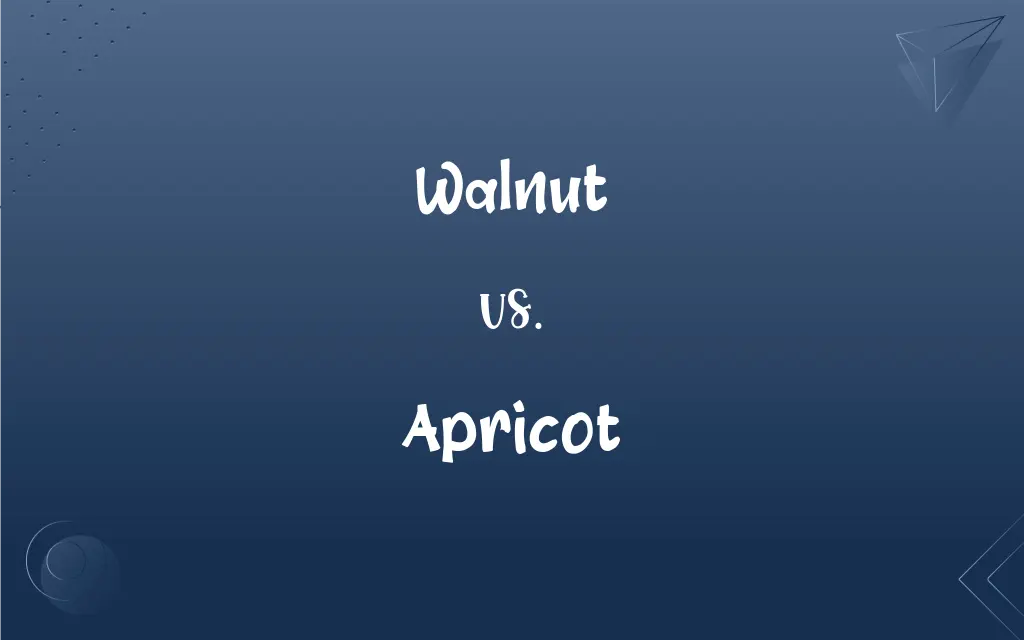Walnut vs. Apricot: What's the Difference?
Edited by Janet White || By Harlon Moss || Updated on November 8, 2023
A walnut is a hard-shelled nut of the walnut tree, while an apricot is a soft, fleshy fruit with a stone.

Key Differences
Walnuts and apricots are both nutritious foods but differ significantly in their botanical categories, textures, and uses. Walnuts are the edible seeds of trees belonging to the genus Juglans, particularly the Persian or English walnut, Juglans regia. They are known for their hard, wrinkled shells and rich, slightly bitter taste. Apricots, in contrast, are the fruits of the apricot tree, Prunus armeniaca, and are recognized by their soft, velvety skin, and sweet, tangy flavor.
A walnut, when cracked open, reveals a lobed kernel, which is high in fats, particularly omega-3 fatty acids, and protein, making it a hearty addition to a diet. Apricots are a source of dietary fiber, vitamins, particularly vitamin A and C, and potassium. While walnuts are often eaten raw, toasted, or used in baking, apricots can be consumed fresh, dried, or cooked into various dishes like jams and pastries.
The physical characteristics of walnuts and apricots are distinct; walnuts have a robust and woody shell that requires a nutcracker to open, while apricots have a soft, fleshy exterior surrounding a hard pit that can be easily removed by hand. The textures once consumed also contrast greatly: walnuts are dense and crunchy, whereas apricots are soft and juicy.
Walnuts have a rich history and are often associated with intelligence due to their brain-like appearance of the kernel, which has made them a symbol of wisdom in various cultures. Apricots, with their golden-orange hue, are often associated with the summer season and have been cultivated in China since ancient times. Both have their roots in ancient agriculture but have spread across the world due to their popularity and adaptability.
Though walnuts and apricots can be grown in similar climates and regions, the trees they come from are quite different in appearance. Walnut trees are large and imposing with a thick trunk and broad leaves, capable of living for hundreds of years. Apricot trees are smaller, with a spreading canopy and beautiful spring blossoms that make them popular in gardens and orchards for both their fruit and their aesthetic appeal.
ADVERTISEMENT
Comparison Chart
Botanical Category
Nut (seed of a drupe)
Fruit (drupe)
Taste
Rich, slightly bitter
Sweet, tangy
Texture
Hard-shelled, crunchy kernel
Soft, fleshy exterior with a stone
Common Uses
Baking, raw, or toasted
Fresh, dried, jams, pastries
Nutritional Content
High in omega-3 fatty acids and protein
High in dietary fiber, vitamins, potassium
ADVERTISEMENT
Walnut and Apricot Definitions
Walnut
Walnuts are often linked to improved brain health.
Eating walnuts is good for your omega-3 intake.
Apricot
An apricot is a small, golden-orange fruit.
She enjoyed a fresh apricot as a snack.
Walnut
Walnut also refers to the dark, hard wood of the walnut tree.
The antique desk was made of walnut.
Apricot
Apricots are rich in vitamins A and C.
Apricots can help improve your skin health.
Walnut
A walnut is a nut from the walnut tree.
Walnuts add a nice crunch to salads.
Apricot
Dried apricots are a popular snack.
He packed a bag of dried apricots for the hike.
Walnut
Botanically, a walnut is the seed of a drupe.
The walnut is encased in a leathery husk before it matures.
Apricot
Apricots are cultivated in temperate regions.
The valley is known for its abundant apricot orchards.
Walnut
In symbolism, walnuts can represent wisdom.
The tradition is to give walnuts to students for good luck in exams.
Apricot
Apricots are versatile in cooking and baking.
Apricot jam is a staple in many pastry recipes.
Walnut
Any of several deciduous trees of the genus Juglans, having pinnately compound leaves and fruits with a rounded sticky husk that encloses an edible seed with a hard shell.
Apricot
A deciduous tree (Prunus armeniaca) native to Asia, having alternate leaves and clusters of usually white flowers.
Apricot
The edible orange-yellow fruit of this tree.
FAQs
Can you eat the shell of a walnut?
No, the shell of a walnut is hard and inedible.
Where do walnut trees grow?
Walnut trees grow in temperate climates around the world.
Do apricots have varieties?
Yes, there are several varieties of apricots varying in size and sweetness.
Is the pit of an apricot edible?
No, the pit of an apricot is not typically eaten.
Can apricots be dried?
Yes, apricots are often dried for long-term storage and snacking.
How can you use apricots in cooking?
Apricots can be eaten fresh, dried, or used in jams, pastries, and savory dishes.
What is a walnut?
A walnut is the edible seed of a tree from the genus Juglans.
What is an apricot?
An apricot is a small, sweet fruit with a stone and soft, orange skin.
What are the health benefits of walnuts?
Walnuts are good for brain health and are high in omega-3 fatty acids.
What are the health benefits of apricots?
Apricots are high in dietary fiber and vitamins A and C.
How can you use walnuts in cooking?
Walnuts can be used in baking, salads, and as a topping for dishes.
Do walnuts come from a type of fruit?
Yes, walnuts come from the fruit of the walnut tree, which is a drupe.
How do you store apricots?
Fresh apricots should be stored at room temperature or refrigerated; dried apricots can be kept in a cool, dry place.
Can you make oil from walnuts?
Yes, walnut oil is used in cooking and as a finish for wood.
Where do apricot trees grow?
Apricot trees thrive in temperate regions with cold winters.
Can apricot kernels be used to extract oil?
Yes, apricot kernel oil is used in cosmetics and for cooking.
Are walnuts a common allergen?
Yes, walnuts are a common food allergen for some people.
How do you store walnuts?
Walnuts should be stored in a cool, dry place, or refrigerated.
What does a walnut taste like?
Walnuts have a rich, earthy flavor that is slightly bitter.
Are walnuts used for their wood?
Yes, walnut wood is prized for furniture and interior finishes.
About Author
Written by
Harlon MossHarlon is a seasoned quality moderator and accomplished content writer for Difference Wiki. An alumnus of the prestigious University of California, he earned his degree in Computer Science. Leveraging his academic background, Harlon brings a meticulous and informed perspective to his work, ensuring content accuracy and excellence.
Edited by
Janet WhiteJanet White has been an esteemed writer and blogger for Difference Wiki. Holding a Master's degree in Science and Medical Journalism from the prestigious Boston University, she has consistently demonstrated her expertise and passion for her field. When she's not immersed in her work, Janet relishes her time exercising, delving into a good book, and cherishing moments with friends and family.































































